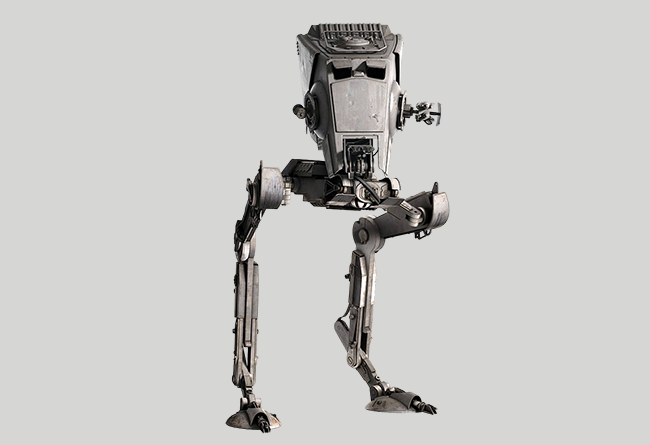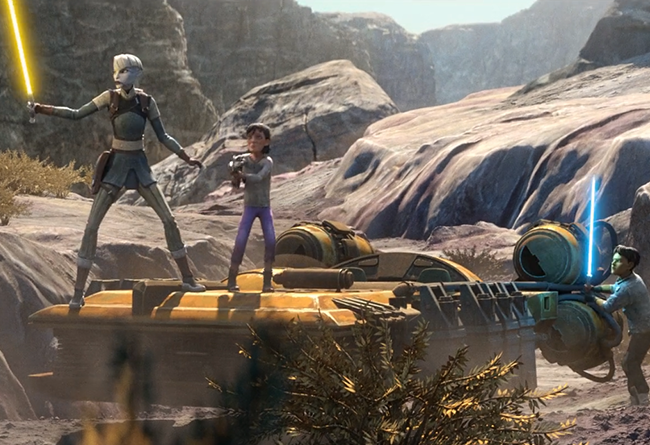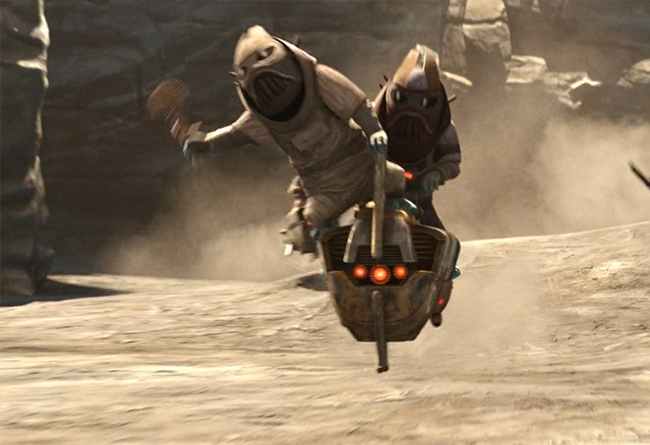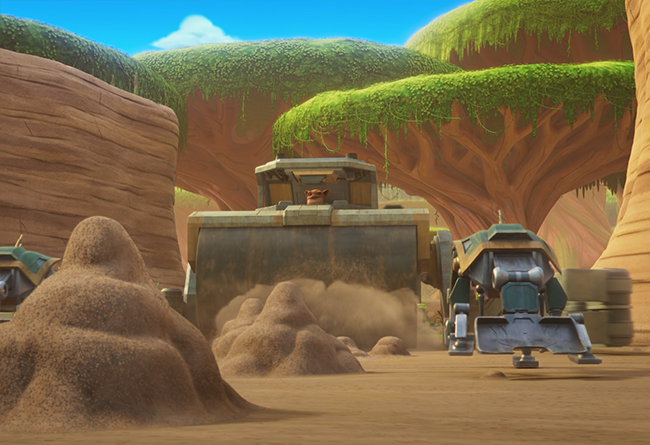Craft: All Terrain Scout Transport
Type: Medium walker
Scale: Walker
Length: 6.4 meters long, 8.6 meters tall
Skill: Walker operation: AT-ST
Crew: 2, skeleton: 1/+15
Crew Skill: Missile weapons 4D, vehicle blasters 4D+2, walker operation 5D
Cargo Capacity: 200 kilograms
Cover: Full
Cost: Not available for sale
Maneuverability: 1D
Move: 30; 90 kmh
Body Strength: 3D
Weapons:
Twin Blaster Cannon
Fire Arc: Front
Crew: 1 (pilot)
Skill: Vehicle blasters
Fire Control: 1D
Range: 50-200/1/2 Km
Damage: 4D
Twin Light Blaster Cannon
Fire Arc: Front
Crew: 1 (co-pilot)
Skill: Vehicle blasters
Fire Control: 1D
Range: 50-300/500/1 Km
Damage: 2D
Concussion Grenade Launcher
Fire Arc: Front
Crew: 1 (co-pilot)
Skill: Missile weapons: grenade launcher
Fire Control: 1D
Range: 10-50/100/200
Damage: 3D
Background: The All Terrain Scout Transport (abbreviated to AT-ST) was a scout and reconnaissance light walker of the Galactic Empire’s All-terrain vehicle line. It consisted of an armored command and control cabin mounted on two gyro-stabilized legs and was utilized for battle line support, antipersonnel hunting and troop support. They were also commonly used to screen the flanks of larger assault walkers for major ground operations, during which they supported heavier walkers such as AT-ATs by eliminating pockets of resistance and clearing out denser terrain such as small canyons and cities along the path of a planned invasion route.
The command cabin featured two armored viewports deliberately set to give any viewer the unsettling sensation of staring into the face of a soulless beast or oversized combat droid, despite not being needed due to the AT-ST extensive sensor package. Inside the control cabin, the command module featured multiple holoprojectors that displayed a 360-degree holographic view of the combat zone. The cabin (or “head”) was capable of rotating 240 degrees side to side, greatly benefiting the gunner’s target-acquisition abilities and capabilities for destruction. A cooling system was equipped above the command module behind the entry hatch.
AT-STs were equipped with two chin-mounted MS-4 twin blaster cannons with a range of two kilometers. They also featured one cheek-mounted 88i twin light blaster cannon and one cheek-mounted DW-3 concussion grenade launcher capable of doing massive damage to enemy vehicles and ground troops at close range and used at dealing with large amounts of infantry as well as mounted turrets that were too risky to be taken out with rocket launchers. AT-STs were also equipped with retractable footpad blades that could slash apart ground-level wires and fences. The modular design of the All Terrain Scout Transport allowed for ease in customizing the walker with armaments and tools for specific mission parameters, including mortar launchers that could be attached to the command pod of the AT-ST.
Several areas of the walker’s hull were reinforced with armored plates, including the rear of the command cabin, which featured the weapon power converters, the front (or “face”), the joints, and the gyro-stabilizing system. In addition, reinforced armor plates enveloped the control cabin, protecting the two-person crew from small-arms fire but not laser cannons, missiles, or other heavy ordnance.
Due to its small size, the AT-ST could not be equipped with an onboard full-power generator. As such, it relied on eight disposable high-intensity power cells mounted directly at its drive engine. Two more cells powered the cabin gyro for redundancy. Despite covering the walker’s high energy needs, these power cells greatly limited its range.
The walker’s deceptively rickety gait belied a potent patrol vehicle. Gyros and flexible joints formed a complex system that controlled balance and stabilized the walker across various terrains. Sophisticated shock absorbers built inside the lower legs of the walker kept it stable at all times, while various sensors built within its footpads offered detailed feedback on the terrain the AT-ST was moving through, reading intensity and contour for precise foot placement. The locomotion computer mounted in the command cabin could take control of the walker and use the information relayed from the sensors to drive it autonomously over even ground. However, an experienced pilot was still needed over complex terrain.
Despite its speed and agility, an AT-ST walker’s offensive and defensive power was significantly compromised. Offensively, its weapons systems were only good against lightly armored targets at close range. Defensively, its lighter armor could repel attacks from small-arms fire but not laser cannons, missiles, or other heavy ordnance. Its armor did not cover its entire frame, lest the walker lose agility. Striking the walker’s unprotected gyros underneath the command module could destabilize it and cause it to fall. Additionally, deep trenches or cable lines leveled at the height of the AT-ST’s ankles and knees could cause it to trip and topple the vehicle. AT-STs also require constant maintenance, having perhaps the highest maintenance-per-hour record in the Imperial Army.
The Ewoks of Endor discovered that the AT-STs were vulnerable to anti-Gorax traps. Ramming logs could smash through the walker’s head, destroying the cockpit. One of its other weaknesses was its susceptibility to hijacking, despite the vehicle’s height seemingly making hijacking an impossibility. A sufficiently strong force could rip the entrance hatch off the top of the walker. The walker’s cannons could easily penetrate other AT-STs’ armor if commandeered.
Appearances: Solo, Episode V The Empire Strikes Back, Episode VI The Return of the Jedi, Episode VIII The Last Jedi





